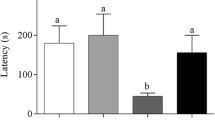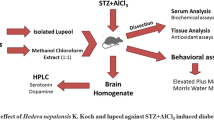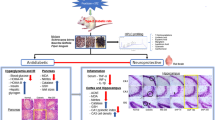Abstract
Loranthus micranthus (LM) is used in the treatment of diabetes and mental disorders in Nigerian folklore medicine. We studied the short-term memory behavior as well as the activity of acetylcholinesterase, antioxidant status and glycolytic flux in cerebrum and cerebellum of diabetic rats treated with LM extract. Histopathological evaluation was used to assess the level of damage on brain tissue due to diabetes complications. Treatment with LM improved short-term memory behavior, significantly reduced the levels of lipid peroxidation (LPO), increased glutathione (GSH) levels and enhanced the activities of antioxidant enzymes. Activities of glucose metabolism enzymes were augmented while acetylcholinesterase (AChE) activity was reduced by LM treatment compared with the untreated diabetic group. Histopathology evaluation revealed the possible influence of LM in reversing diabetes-induced damage in brain tissue. Further studies are required to accentuate the potentials of LM extract in assuaging diabetes-induced neurological deficits.







Similar content being viewed by others
REFERENCES
Kaplan, M., Aviram, M., and Hayek, T., Pharm. Therap., 2012, vol. 136, pp. 175–185.
Prickaerts, J., Fahrig, T., and Blokland, A., Behav. Brain. Res., 1999, vol. 102, pp. 73–88.
Price, J., Verma, S., and Li, R.K., Heart Fail. Rev., 2003, vol. 8, pp. 213–219.
Sharifzadeh, M., Ranjbar, A., Hosseini, A., and Khanavi, M., Iran. J. Pharm. Res., 2017, vol. 16, no. 1, pp. 201–209.
Ebokaiwe, A.P., Ijomone, O.M., Edeh, O.,Oteh, I., and Ebuka, D.E., J. Basic Clin. Physiol. Pharmacol., 2018. https://doi.org/10.1515/jbcpp-2017-0092
Vinayagam, R., and Xu, B., Nutr. Metab., 2015, vol. 12, p. 60.
Channabasava, G.M., Chandrappa, C.P., and Umashankar, T., J. Diabetes Metab., 2015, vol. 6, pp. 5–14.
Osadebe, P.O., and Ukweze, S.E., J. Biol. Res. Biotech., 2004, vol. 2, pp. 18–23.
Obatomi, D.K., Bikomo, E.O., and Temple, V.J., J. Ethnopharmacol., 1994, vol. 43, pp. 13–17.
Osadebe, P.O., Omeje, E.O., Uzor, P.F., David, E.K., and Obiorah, D.C., Asian Pacif. J. Tropic. Med., 2010, vol. 3, pp. 196–199.
Ijomone, O.M., Olaibi, O.K., Biose, I.J., Mba, C., Tete, S.A., and Nwoha, P.U. Pathophysiology, 2015, vol. 22, no. 1, pp. 57–63.
Mori, Y., Cao, D., Li, X., Yin, J., Wang, Z., and Zhang, Y., Int. J. Mol. Sci., 2014, vol. 15, pp. 7667–7683.
Ijomone, O.M., Olaibi, O.K., Biose, I.J., Mba, C., Umoren, K.E., and Nwoha, P.U., Ann. Neurosci., 2014, vol. 21, no. 2, pp. 42–46.
Naqvi, F., Haider, S., Batool, Z., Perveen, T., and Haleem, D.J., Pharmcal. Rep., 2012, vol. 64, pp. 64–69.
Lowry, O.H., Rosenbrough, N.J., Farr, A.L., and Randall, R.J., J. Biol. Chem 1951, vol. 193, pp. 265–275.
Misra, H.P. and Fridovich, I., J. Biol. Chem., 1972, vol. 247, pp. 3170–3175.
Claiborne, A., Handbook of Methods for Oxygen Radical Research, Greenwald, A.R. (Ed.), Boca Raton, CRC Press, 1995, pp. 237–242.
Jollow, D.J., Mitchell, J.R., Zampaglione, N., and Gillette, J.R., Pharmacol., 1974, vol. 11, pp. 151–169.
Rotruck, J.T., Pope, A.L., Ganther, H.E., Swanson, A.B., and Hoekstra, W.G., Science, 1973, vol. 179, pp. 588–590.
Farombi, E.O., Tahnteng, J.G., and Agboola, A.O., Food Chem. Toxicol., 2000, vol. 38, pp. 535–541.
Ellman, G.L., Courtney, K.D., Andres, V., and Featherstone, R.M., Biochem. Pharmacol., 1961, vol. 7, pp. 88–95.
Branstrup, N., Krik, J.E., and Bruni, C., J. Gerontol., 1957, vol. 12, pp. 166–171.
Dawson, R.C.M., Elliott, D.C., Elliott, W.H., and Jones K.M., Data for Biochemical Research, 2nd ed., Oxford, Clarendon Press, 1969, pp. 483–498.
Ebokaiwe, A.P. and Farombi, E.O., J. App. Life. Sci. Inter., 2016, vol. 5, pp. 1–11.
Moghadamtousi, S.Z., Hajrezaei, M., Abdul-Kadir, H., and Zandi, K., Evidence-Based Compl. Altern. Med., 2013, Article ID 273712.
Maritim, A.C., Sanders, R.A., and Watkins, J.B., J. Nutr. Biochem., 2003, vol. 14, pp. 288–294.
Vestergoard, H., Dan. Med. Bull., 1999. vol. 46, pp. 13–34.
Sato, T., Magata, K., and Koga, N., Biochem. Biophys. Res. Commun., 1998, vol. 245, pp. 378–381.
Griendling, K.K., Sorescu, D., and Ushio-Fukai, M., Circ. Res., 2000, vol. 86, pp. 494–501.
Mao, Y., Cao, D., Li, X., Yin, J., Wang, Z., and Zhang, Y., Int. J. Mol. Sci., 2014, vol. 15, pp. 7667–7683.
Wang, J., Yin, J., Song, Y., Zhang, L., Ren, Y., and Wang, D., J. Diab. Res., 2014, Article ID 796840, https://doi.org/10.1155/2014/796840
Chen, C., Wang, Y., Zhang, J., Ma, L., Gu, J., and Ho, G., Dis. Model. Mech., 2014, vol. 7, pp. 723–730.
Haider, S., Ahmed, S., Tabassum, S., Memon, Z., Ikram, M., and Haleem, D.J., Acta Neurol. Belg., 2013, vol. 113, pp. 35–41.
Meeter, M., Talamini, L., Schmitt, J.A.J., and Riedel, W.M. Neuropsychopharmacology, 2005, vol. 31, pp. 712–720.
van Elderen, S.G.C., de Roos, A., de Craen, A.J.M., Westendorp, R.G.J., Blauw, G.J., and Jukema, J.W., Neurology, 2010, vol. 75, pp. 997–1002.
van Harten, B., de Leeuw, F.E., Weinstein, H.C., Scheltens, P., and Biessels, G.J., Diabetes Care, 2006, vol. 29, pp. 2539–2548.
Huang, M., Gao, L., Yang, L., Lin, F., and Le, H., NeuroImage: Clinical, 2012, vol. 1, pp. 57–65.
Ozdemir, N.G., Akbas, F., Kotil, T., and Yilmaz, A., Turk. J. Med. Sci., 2016, vol. 46, pp. 1579–1592.
Orgel, E. and Mittelman, S.D., Curr. Diab. Rep., 2013, vol. 13, no. 2, pp. 213–222.
Chambless, L.B., Parker, S.L., Hassam-Malani, L., McGirt, M.J., and Thompson R.C., J. Neuro-Oncol., 2012, vol. 106, no. 2, pp. 383–389.
Giovannucci, E., Harlan, D.M., Archer, M.C., Bergenstal, R.M., Gapstur, S.M., and Habel, L.A., CA: Cancer J. Clin., 2010, vol. 60, no. 4, pp. 207–221.
Tieu, M.T., Lovblom, L.E., McNamara, M.G., Mason, W., Laperriere, N., Millar, B., J. Neuro-Oncol., 2015, vol. 124, pp. 119–126.
Funding
This work was supported by FUNAI Institutional based TETFUND grant with code FUNAI/FST/14/B2/022 awarded to Dr. Azubuike Ebokaiwe.
Author information
Authors and Affiliations
Corresponding author
Ethics declarations
Conflict of interest. The authors declare that there are no conflicts of interest.
Ethical approval. All animals received humane care according to the criteria outlined in the “Guide for the Care and Use of Laboratory Animals” prepared by the National Academy of Science (NAS) and published by the National Institute of Health. The experiment was performed in accordance with the guidelines and approval of institutional animal ethics committee AE-FUNA.
Rights and permissions
About this article
Cite this article
Ebokaiwe, A.P., Ijomone, O.M., Osawe, S.O. et al. Influence of Loranthus micranthus against STZ-Induced Neurobehavioral Deficits in Diabetic Rats. Neurochem. J. 13, 283–294 (2019). https://doi.org/10.1134/S1819712419030061
Received:
Revised:
Accepted:
Published:
Issue Date:
DOI: https://doi.org/10.1134/S1819712419030061




